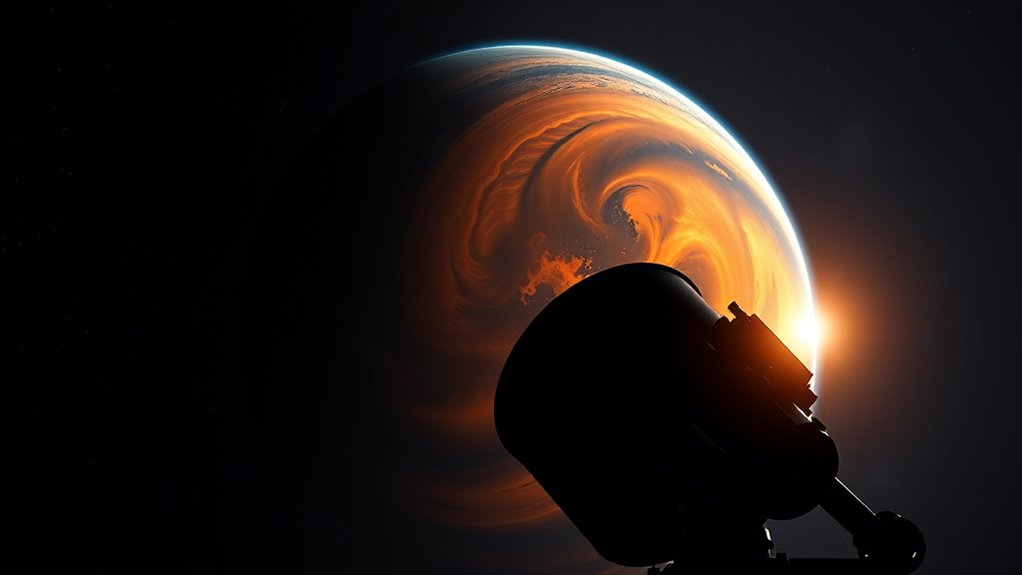The Webb Telescope has detected key molecules like water vapor, carbon dioxide, methane, and oxygen on a distant exoplanet, providing detailed insights into its atmosphere. These findings help you understand the planet’s climate, potential habitability, and whether conditions could support life. By analyzing these gases, scientists can determine if the planet might have surface water or biosignatures. Keep exploring to discover how this breakthrough advances our quest to find Earth-like worlds.
Key Takeaways
- Webb Telescope captures detailed spectra revealing atmospheric molecules like water vapor, carbon dioxide, and methane on distant exoplanets.
- Detection of key gases helps assess planetary habitability and potential for liquid water or life-supporting conditions.
- Spectral analysis distinguishes between different atmospheric compositions, indicating climate dynamics and geological processes.
- Identifying biosignature gases provides clues about possible biological activity on exoplanets.
- These observations advance understanding of exoplanet environments, guiding future exploration and habitability assessments.

The James Webb Space Telescope has opened a new chapter in our understanding of exoplanet atmospheres by providing unprecedented detail and clarity. When you look at distant worlds, you might wonder what makes them unique, especially regarding their atmospheric composition and potential to support life. Webb’s advanced instruments allow you to analyze these atmospheres directly, revealing the presence of key molecules that shape the environment of these planets. This breakthrough helps you piece together whether a planet could be habitable or if its atmosphere is too hostile for life as we know it.
By studying the specific gases present in an exoplanet’s atmosphere, you gain insight into its overall atmospheric composition. Webb detects molecules like water vapor, carbon dioxide, methane, and oxygen, each telling a different story about the planet’s climate, geology, and potential for supporting life. For example, the detection of water vapor signals that liquid water could exist on the surface, a critical factor for habitability. Conversely, high levels of greenhouse gases like CO2 can indicate a thick, possibly uninhabitable atmosphere. When you analyze the ratios and presence of these molecules, you can better understand the planet’s climate dynamics and whether conditions are suitable for life.
You also realize that atmospheric composition directly impacts exoplanet habitability. Webb’s ability to identify specific molecules helps you assess if a planet’s surface conditions could be conducive to life. For instance, detecting oxygen alongside water vapor might suggest biological activity, although you’re cautious about over-interpreting these signals. Still, these clues are invaluable in prioritizing planets for further study. If the atmosphere contains hazardous gases or lacks essential elements, you understand that such planets are less likely to be habitable. The telescope’s detailed spectra allow you to distinguish between planets with potential biosignatures and those with atmospheres dominated by gases that are toxic or inhospitable.
In essence, Webb’s observations bring you closer to answering one of humanity’s biggest questions: Are we alone? By unraveling the atmospheric composition of distant exoplanets, you get a glimpse into their potential to harbor life. This isn’t just about cataloging planets; it’s about understanding their environments deeply enough to evaluate habitability. The data Webb provides helps you understand the complex interplay of gases and conditions that define a planet’s suitability for life, moving us nearer to discovering worlds that might resemble our own.
Frequently Asked Questions
What Are the Potential Signs of Life on Exoplanets?
When searching for signs of life on exoplanets, you’re looking for biosignature detection and atmospheric markers that suggest biological activity. These include gases like oxygen, methane, or water vapor that coexist in ways indicating life processes. If you spot such atmospheric markers, it’s a strong hint that the planet might host life. Keep in mind, detecting these signs is complex but essential for understanding potential habitability beyond our solar system.
How Does Atmospheric Composition Influence Habitability?
Think of a planet’s atmosphere as its cloak, shaping its ability to support life. Your planet’s habitability factors depend on atmospheric composition and dynamics—like a carefully balanced dance of gases. If the atmosphere holds essential molecules like water vapor, oxygen, and carbon dioxide, it creates a nurturing environment. Conversely, harsh or unstable atmospheres hinder life. So, understanding these atmospheric qualities helps determine whether a planet can sustain life or remains inhospitable.
Can Webb Detect Biosignatures on Distant Exoplanets?
You wonder if Webb can detect biosignatures on distant exoplanets. It’s capable of atmosphere analysis, allowing you to identify gases like oxygen or methane that could indicate life. Through biosignature detection, Webb analyzes atmospheric composition, helping you determine if planets might host life. Its advanced instruments enable you to study exoplanet atmospheres in detail, bringing you closer to discovering signs of life beyond our solar system.
What Challenges Are Faced in Analyzing Exoplanet Atmospheres?
Imagine trying to hear a whisper in a thunderstorm—that’s what analyzing exoplanet atmospheres can feel like. You face challenges from instrumental limitations that blur signals and make data interpretation tricky. These hurdles hinder your ability to precisely identify atmospheric molecules and biosignatures. Overcoming them requires advanced technology and meticulous analysis, so you can better understand these distant worlds and reveal their secrets amidst the cosmic noise.
How Will This Discovery Impact Future Space Exploration?
Your discovery will substantially impact future space exploration by advancing our understanding of exoplanet atmospheres, which is vital for interstellar travel and planetary colonization. With detailed atmospheric data, you can identify potential habitable worlds and develop better technology for long-distance journeys. This progress fuels hopes of reaching other systems, making interstellar travel more feasible, and ultimately, establishing colonies beyond our solar system.
Conclusion
You’ve just seen how the Webb Telescope uncovers vital atmospheric molecules on a distant exoplanet, bringing us closer to understanding alien worlds. Imagine this: scientists detected water vapor in its atmosphere, a key ingredient for life, on a planet 300 light-years away. This incredible discovery fuels our curiosity and hope for finding life beyond Earth. The universe’s vastness may seem intimidating, but moments like this remind us that exploration brings us closer to answers we once only dreamed of.









